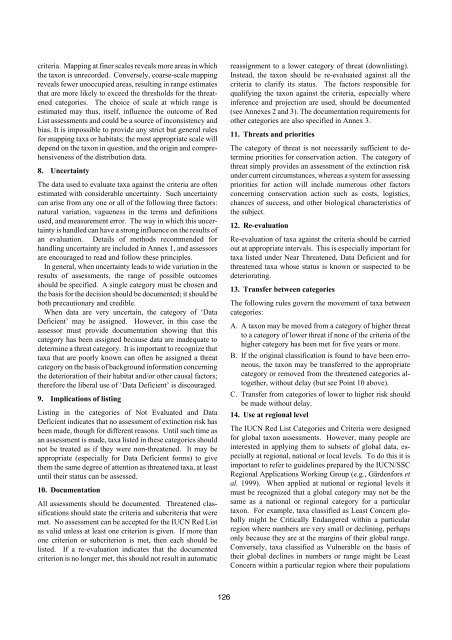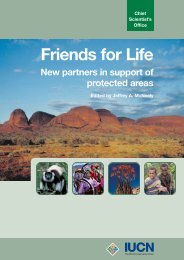Dolphins, Whales and Porpoises: 2002-2010 Conservation - IUCN
Dolphins, Whales and Porpoises: 2002-2010 Conservation - IUCN
Dolphins, Whales and Porpoises: 2002-2010 Conservation - IUCN
You also want an ePaper? Increase the reach of your titles
YUMPU automatically turns print PDFs into web optimized ePapers that Google loves.
criteria. Mapping at finer scales reveals more areas in which<br />
the taxon is unrecorded. Conversely, coarse-scale mapping<br />
reveals fewer unoccupied areas, resulting in range estimates<br />
that are more likely to exceed the thresholds for the threatened<br />
categories. The choice of scale at which range is<br />
estimated may thus, itself, influence the outcome of Red<br />
List assessments <strong>and</strong> could be a source of inconsistency <strong>and</strong><br />
bias. It is impossible to provide any strict but general rules<br />
for mapping taxa or habitats; the most appropriate scale will<br />
depend on the taxon in question, <strong>and</strong> the origin <strong>and</strong> comprehensiveness<br />
of the distribution data.<br />
8. Uncertainty<br />
The data used to evaluate taxa against the criteria are often<br />
estimated with considerable uncertainty. Such uncertainty<br />
can arise from any one or all of the following three factors:<br />
natural variation, vagueness in the terms <strong>and</strong> definitions<br />
used, <strong>and</strong> measurement error. The way in which this uncertainty<br />
is h<strong>and</strong>led can have a strong influence on the results of<br />
an evaluation. Details of methods recommended for<br />
h<strong>and</strong>ling uncertainty are included in Annex 1, <strong>and</strong> assessors<br />
are encouraged to read <strong>and</strong> follow these principles.<br />
In general, when uncertainty leads to wide variation in the<br />
results of assessments, the range of possible outcomes<br />
should be specified. A single category must be chosen <strong>and</strong><br />
the basis for the decision should be documented; it should be<br />
both precautionary <strong>and</strong> credible.<br />
When data are very uncertain, the category of ‘Data<br />
Deficient’ may be assigned. However, in this case the<br />
assessor must provide documentation showing that this<br />
category has been assigned because data are inadequate to<br />
determine a threat category. It is important to recognize that<br />
taxa that are poorly known can often be assigned a threat<br />
category on the basis of background information concerning<br />
the deterioration of their habitat <strong>and</strong>/or other causal factors;<br />
therefore the liberal use of ‘Data Deficient’ is discouraged.<br />
9. Implications of listing<br />
Listing in the categories of Not Evaluated <strong>and</strong> Data<br />
Deficient indicates that no assessment of extinction risk has<br />
been made, though for different reasons. Until such time as<br />
an assessment is made, taxa listed in these categories should<br />
not be treated as if they were non-threatened. It may be<br />
appropriate (especially for Data Deficient forms) to give<br />
them the same degree of attention as threatened taxa, at least<br />
until their status can be assessed.<br />
10. Documentation<br />
All assessments should be documented. Threatened classifications<br />
should state the criteria <strong>and</strong> subcriteria that were<br />
met. No assessment can be accepted for the <strong>IUCN</strong> Red List<br />
as valid unless at least one criterion is given. If more than<br />
one criterion or subcriterion is met, then each should be<br />
listed. If a re-evaluation indicates that the documented<br />
criterion is no longer met, this should not result in automatic<br />
126<br />
reassignment to a lower category of threat (downlisting).<br />
Instead, the taxon should be re-evaluated against all the<br />
criteria to clarify its status. The factors responsible for<br />
qualifying the taxon against the criteria, especially where<br />
inference <strong>and</strong> projection are used, should be documented<br />
(see Annexes 2 <strong>and</strong> 3). The documentation requirements for<br />
other categories are also specified in Annex 3.<br />
11. Threats <strong>and</strong> priorities<br />
The category of threat is not necessarily sufficient to determine<br />
priorities for conservation action. The category of<br />
threat simply provides an assessment of the extinction risk<br />
under current circumstances, whereas a system for assessing<br />
priorities for action will include numerous other factors<br />
concerning conservation action such as costs, logistics,<br />
chances of success, <strong>and</strong> other biological characteristics of<br />
the subject.<br />
12. Re-evaluation<br />
Re-evaluation of taxa against the criteria should be carried<br />
out at appropriate intervals. This is especially important for<br />
taxa listed under Near Threatened, Data Deficient <strong>and</strong> for<br />
threatened taxa whose status is known or suspected to be<br />
deteriorating.<br />
13. Transfer between categories<br />
The following rules govern the movement of taxa between<br />
categories:<br />
A. A taxon may be moved from a category of higher threat<br />
to a category of lower threat if none of the criteria of the<br />
higher category has been met for five years or more.<br />
B. If the original classification is found to have been erroneous,<br />
the taxon may be transferred to the appropriate<br />
category or removed from the threatened categories altogether,<br />
without delay (but see Point 10 above).<br />
C. Transfer from categories of lower to higher risk should<br />
be made without delay.<br />
14. Use at regional level<br />
The <strong>IUCN</strong> Red List Categories <strong>and</strong> Criteria were designed<br />
for global taxon assessments. However, many people are<br />
interested in applying them to subsets of global data, especially<br />
at regional, national or local levels. To do this it is<br />
important to refer to guidelines prepared by the <strong>IUCN</strong>/SSC<br />
Regional Applications Working Group (e.g., Gärdenfors et<br />
al. 1999). When applied at national or regional levels it<br />
must be recognized that a global category may not be the<br />
same as a national or regional category for a particular<br />
taxon. For example, taxa classified as Least Concern globally<br />
might be Critically Endangered within a particular<br />
region where numbers are very small or declining, perhaps<br />
only because they are at the margins of their global range.<br />
Conversely, taxa classified as Vulnerable on the basis of<br />
their global declines in numbers or range might be Least<br />
Concern within a particular region where their populations






